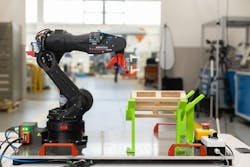Kawasaki Robotics’ Offers Robots for Hands-On Educational Experience
Kawasaki Robotics has released Astorino, a robotics platform for industrial/technical education providers. Astorino reportedly offers the capabilities of a modern industrial robot at a fraction of the cost of other robots for the educational market, enabling educators to more easily equip students with foundational, real-world skills.
Named after the open-source Arduino platform and development partner Astor, Astorino leverages Kawasaki Robotics’ technology expertise, including hardware, firmware, control system, application software and training. The platform also supplies STL (stereolithography) files so students can rapidly print 3D replacement parts for 99% of the robot.
At the core of Astorino is a 1 kg payload, 6-axis robot with a structure and programming environment nearly identical to that of a Kawasaki industrial robot. Weighing 12 kg and powered by a 110V outlet, the robot can operate in any classroom environment. The Astorino platform includes a built-in control system, dedicated firmware and software, Modbus TCP and USB/Ethernet communication, and safety functions such as e-stop and safety brakes. The platform’s motor control uses three signals (pulse, direction, enable) and steel gears reduce backlash to <5 arcmin. The robot can also be paired with multiple options such as three kinds of grippers, a 24V I/O module, a cube feeder with optical sensors and external sensors.
Pricing
At a base price of $5,000, Kawasaki says this price point enables educators to provide a low student-to-equipment ratio so that each student can spend more time directly working with the robots. This interactive learning approach not only increases knowledge retention in areas such as mechatronics and programming but also provides a comprehensive view of robotic systems to prepare students for real-world application environments while sparking their interest in the field.
Astorino was designed to be cost-effective for learning institutions by minimizing operational, maintenance and recurring costs. The development environment includes dedicated firmware, free software and a free code editor. By eliminating recurring costs such as software licenses and replacement parts (students can print 3D parts as noted above), educators have a clear idea of costs and can focus on teaching rather than budgeting.
“We launch the Astorino with a clear goal: To advance industrial robotics education,” said Paul Marcovecchio, director – general industries, Kawasaki Robotics (USA) Inc. “With this new cost-effective and dynamic robotic platform, we eliminate many barriers to entry that have kept educators from providing advanced robotics design tools to their students. Our accessible price point and ease of use will enable more educators to offer the valuable hands-on experiences so critical to success in today’s manufacturing environments.”

